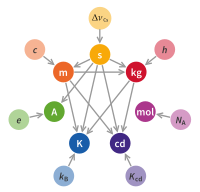Length
This is Wikipedia's current article for improvement – and you can help edit it! You can discuss how to improve it on its talk page and ask questions at the help desk or Teahouse. See the cheatsheet, tutorial, editing help and FAQ for additional information. Editors are encouraged to create a Wikipedia account and place this article on their watchlist.
Find sources: "Length" – news · newspapers · books · scholar · JSTOR |
| Length | |
|---|---|
Common symbols | l |
| SI unit | metre (m) |
Other units | see unit of length |
| Extensive? | yes |
| Dimension | L |
Length is a measure of distance. In the International System of Quantities, length is a quantity with dimension distance. In most systems of measurement, the unit of length is a base unit, from which other units are derived. Length is commonly understood to mean the most extended dimension of an object.[1]
Types of length include height, which is vertical length or vertical extent, and width or breadth, which are the side-to-side length, measuring across the object at right angles to the height.
Length is the measure of one spatial dimension, whereas area is a measure of two dimensions (length squared) and volume is a measure of three dimensions (length cubed).
History
Measurement has been important ever since humans settled from nomadic lifestyles and started using building materials, occupying land and trading with neighbours. As trade between different places increased, the need for standard units of length increased. And later, as society has become more technologically oriented, much higher accuracy of measurement is required in an increasingly diverse set of fields, from micro-electronics to interplanetary ranging.[2]
Under Einstein's special relativity, length can no longer be thought of as being constant in all reference frames. Thus a ruler that is one metre long in one frame of reference will not be one metre long in a reference frame that is moving relative to the first frame. This means the length of an object varies depending on the speed of the observer.
Use in mathematics
Euclidean geometry
In Euclidean geometry, length is measured along straight lines unless otherwise specified. Pythagoras's theorem relating the length of the sides of a right triangle is an application in Euclidean geometry. Length may also be measured along other types of curves and is referred to as arclength or pathlength.
Other geometries
In other geometries, length may be measured along curved paths, called geodesics. The Riemannian geometry used in general relativity is an example of such a geometry.
Measure theory
In measure theory, length is most often generalized to general sets of via the Lebesgue measure. In the one-dimensional case, the Lebesgue outer measure of a set is defined in terms of the lengths of open intervals. Concretely, the length of an open interval is first defined as
so that the Lebesgue outer measure of a general set may then be defined as[3]
Units
In the physical sciences and engineering, when one speaks of units of length, the word length is synonymous with distance. There are several units that are used to measure length. Historically, units of length may have been derived from the lengths of human body parts, the distance traveled in a number of paces, the distance between landmarks or places on the Earth, or arbitrarily on the length of some common object.
In the International System of Units (SI), the basic unit of length is the metre (symbol, m) and is now defined in terms of the speed of light (about 300 million metres per second). The millimetre (mm), centimetre (cm) and the kilometre (km), derived from the metre, are also commonly used units. In U.S. customary units, English or Imperial system of units, commonly used units of length are the inch (in), the foot (ft), the yard (yd), and the mile (mi). A unit of length used in navigation is the nautical mile (nmi).
Units used to denote distances in the vastness of space, as in astronomy, are much longer than those typically used on Earth and include the astronomical unit (au), the light-year, and the parsec (pc).
See also
References
- ^ Princeton.edu
- ^ History of Length Measurement, National Physical Laboratory
- ^ Le, Dung. "Lebesgue Measure" (PDF).
{{cite web}}: CS1 maint: url-status (link)






